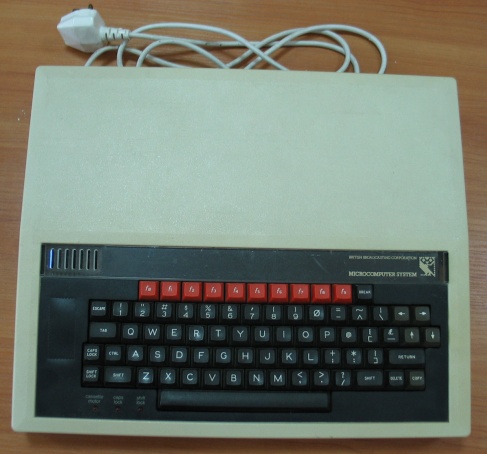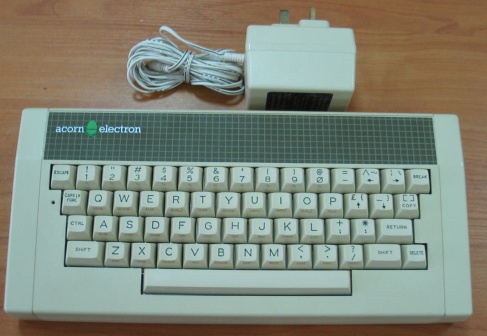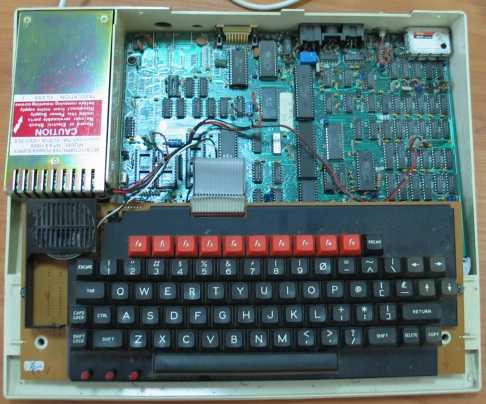BBC Micro and Acorn Electron – I like these two computers from my retro vintage computers collection as there is interesting story around them.
Everyone has heard for ARM processors, the fastest growing architecture, they are everywhere: in phones, tablets, handheld devices, GPS navigators, media players, set top boxes and in most of Android devices. Nova days we have even Cortex-M0 ARM processors for $0.30 which penetrates the holy territory of the 8-bit processors.
If you now ask yourself What ARM processors do have with the above retro computers, the answer is simple, because of these computers ARM processors were designed in first place.
How this happend:
Back in 1970s Chris Curry is Cambridge University professor with interest in the microprocessors, he launched together with his friend Herman Hauser two companies: first with research in the microcprocessors named Cambridge Processor Unit Ltd (CPU) and another named Acorn Microcomputer with aim to make mini computer based on the CPU processors.
According to Curry the Acorn name was choosen so it appear before Apple in the telephone directory, which show which company they were influenced at that time.
Some engineers joined to work in Acorn Computers and one of them Sophie Wilson designed few computer systems there. These were primary laboratory oriented kits with LCDs, keyboards, processors which allow laboratory exercises to be completed with students – looking same as Olimex’s development boards now 🙂
In 1979 Curry influenced by ZX81 computer launch decided also to move to home computer design and this is how Acorn Atom was build. Based on 6502 as any other home computer at that time.
After the Atom was released Curry and the team started thinking for more powerful processor, Hauser suggested compromise 6502 with enhanced peripheral co-processor which to unload 6502 from the part of the tasks so they designed the next version Proton.
BBC in 1981 selected Proton for their educational program and the computer was renamed to BBC micro. Acorn sold more than 1.5 million BBC microcomputers and this helped the company to make enough profit to start working on their own processor. With the launch of IBM PC in 1981 and the Apple Lisa Acorn saw that they need more powerful processor, first attempt was to contact Intel to licensee 268 and improve it, but Intel refused so they as University professors decided that its not so hard to make their own 🙂
At that time everyone has put efforts to make processors which machine language is close to higher level programming languages i.e. so named CISC (complex instruction set computing) processors. The idea was that programming language would be easy to translate and execute faster if the machine language instructions are close to it. This lead to very complex implementation of the processor, long signal paths, which didn’t allow high frequencies (most processors at that time run at 1-2Mhz) and it was taking about 100 man years to develop something like 6502. Acorn had no such resources so they went to different route – to make RISC (reduced instruction set computing) processor which was easier to develop with smaller budged and team. Sophie Wilson set about developing the instruction set, writing a simulation of the processor in BBC Basic that ran on a BBC Micro with a 6502 second processor. Another benefit from the RISC architecture came the smaller paths to implement and the higher frequencies and lower power supply the RISC processor required compared to CISC processor. First RISC processors were running at 4Mhz and the power consumption was less than CISC. Smaller size also means less cost to manufacture.
It convinced the Acorn engineers that they were on the right track. Before they could go any further, however, they would need more resources. It was time for Wilson to approach Hauser and explain what was afoot. Once the go-ahead had been given, a small team was put together to implement Wilson’s model in hardware.
The official Acorn RISC Machine (ARM) project started in October 1983, with Acorn spending GBP 5 million on it by 1987. VLSI Technology, Inc were chosen as silicon partner, since they already supplied Acorn with ROMs and some custom chips. VLSI produced the first ARM silicon on 26 April 1985 — it worked first time and came to be known as ARM1. Its first practical application was as a second processor to the BBC Micro, where it was used to develop the simulation software to finish work on the support chips (VIDC, IOC, MEMC) and to speed up the operation of the CAD software used in developing ARM2. The ARM evaluation system was promoted as a means for developers to try the system for themselves. This system was used with a BBC Micro and a PC compatible version was also planned. Advertising was aimed at those with technical expertise, rather than consumers and the education market, with a number of technical specifications listed in the main text of the adverts. Wilson subsequently coded BBC Basic in ARM assembly language, and the in-depth knowledge obtained from designing the instruction set allowed the code to be very dense, making ARM BBC Basic an extremely good test for any ARM emulator.
In 1982 Acorn released budged version with lower cost of BBC micro called BBC Electron, it was with co-processor IC ULA which had inside all logic and peripherals of BBC implemented.
Unfortunately Electron come to the market late as meantime Commodore 64 wiped all competitors in 8-bit scene, Atari and many others went in bancrupcy in 1985, Apple was about to sink also, same happen with Acorn. Olivetti take it over, but the new processor activity was kept in such secret that Olivetti even didn’t know that they buy it.
Good move from Acorn management was to present the new ARM processors to Apple and they decided to use it in their handheld Newton device as were impressed by the price, power and performance of this new chip, so Apple and Acorn began to collaborate of developing the ARM so they formed new company ARM Ltd in November 1990 where Acorn Group and Apple had each x 43% and the VLSI was both investor and first ARM licensee.
Now back to our retro computers:
Here is how BBC Micro looks on bot:
and back:
Note the many peripheral chips, this was one of most advanced computers at that time, it had, LAN, Graphics co-processor, Audio co-processor, needles to say some of most interesting games were on BBC micro 😉
The BBC Electron
bot:
inside:
as you can see all glue logic and peripheral were fit inside custom chip :
which allow BBC Electron to be sold under 200 GBP, sure this didn’t help to complete the mighty Commodore 64 which wiped all 8-bit market, but the research to make newer faster better processor for the Acorn computers lead to the design of one of most successful architecture at our time ARM










Jul 27, 2013 @ 14:31:53
I wrote my first BASIC and assembler on a model B 🙂
Sep 04, 2013 @ 19:56:45
Here is a nice teardown and repair attempt video of an Acorn Archimedes A3000 that somebody who bought a defective machine off eBay made, saying it was the last model made by BBC Micro (1989). The blog post also links to service and reference manual and schematics: http://www.eevblog.com/2013/08/15/eevblog-507-the-first-arm-computer-acorn-archimedes-a3000/
Aug 26, 2017 @ 20:03:18
Chris Curry was not a Cambridge University professor! He was an electronic engineer who worked for Clive Sinclair since 19966 to 1979. Check it on Wikipedia https://en.wikipedia.org/wiki/Christopher_Curry